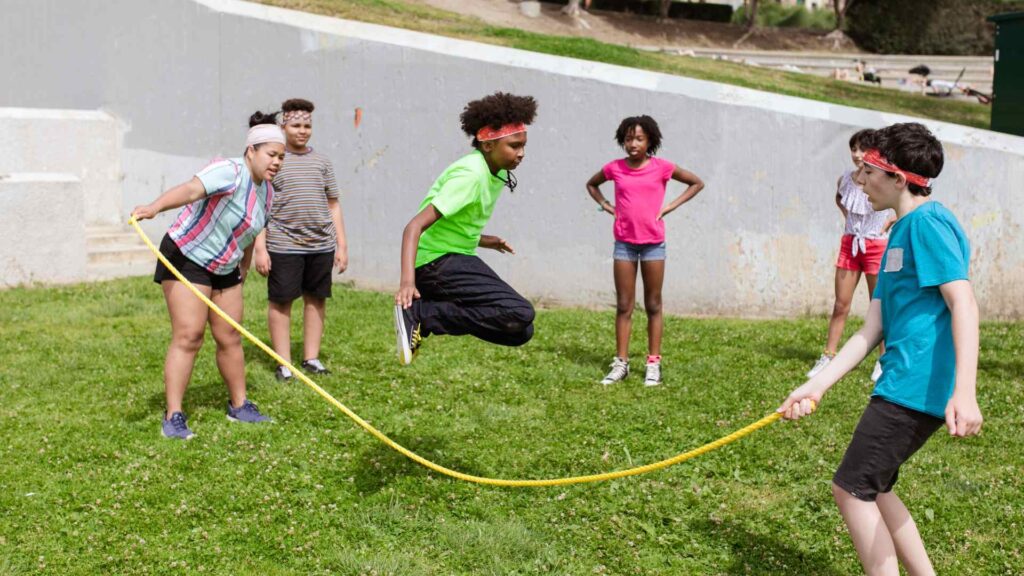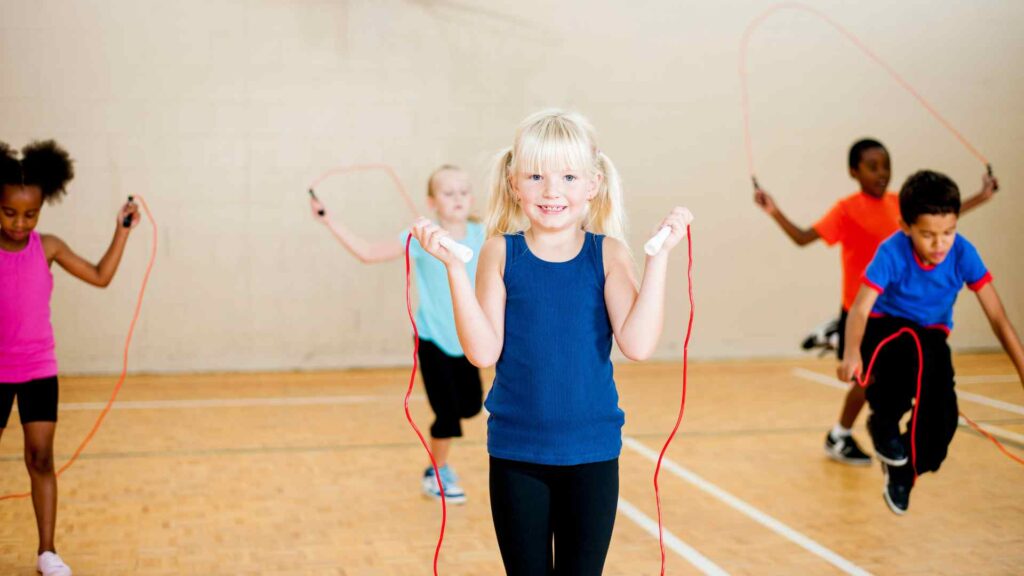Jump into the fun with our ultimate guide to the top 18 jump rope challenges for kids!
From basic jumps to advanced tricks, discover exciting ways to stay active and healthy while having a blast.
The Basics of Jump Rope
Equipment Needed
Before diving into the challenges, it’s essential to have the right equipment. Here’s what you’ll need:
- Jump Rope: Choose a rope that suits your child’s height and skill level. Adjustable ropes are great for growing kids.
- Comfortable Shoes: Proper footwear is crucial to prevent injuries and ensure comfort.
- Non-slip Surface: A flat, non-slip surface, such as a gym floor or driveway, is ideal for jumping.
Basic Jump Rope Techniques
To get the most out of your jump rope challenges, mastering the basics is key. Here are some fundamental techniques:
- The Basic Jump:
- Starting Position: Stand with feet together and rope behind you.
- Swing and Jump: Swing the rope over your head and jump as it reaches your feet.
- Timing: Aim for a smooth, consistent rhythm.
- Jump Rope Stance:
- Feet: Keep feet close together or shoulder-width apart.
- Arms: Keep elbows close to your sides with wrists doing most of the work.
- Posture: Maintain an upright posture with eyes forward.
- Breathing:
- Inhale and Exhale: Develop a breathing pattern to maintain stamina.
Safety Tips
Safety should always come first when kids are engaging in physical activities. Here are some tips to ensure a safe jump rope experience:
- Warm-Up and Stretch: Start with a light warm-up and stretching to prevent muscle strains.
- Proper Footwear: Ensure kids wear supportive shoes to cushion their jumps.
- Safe Surface: Jump on a smooth, even surface to avoid tripping.
- Supervision: Always supervise younger children to prevent accidents.
- Stay Hydrated: Keep a water bottle handy to stay hydrated during the activity.
Jump rope is a fantastic way to combine fun and fitness.
By starting with the right equipment, mastering basic techniques, and prioritizing safety, kids will be ready to take on the jump rope challenges ahead!

Solo Jump Rope Challenges
Basic Jump
Description of the Challenge: The basic jump is the foundation of all jump rope activities. It’s simple yet effective for building stamina and coordination.
Steps to Master the Basic Jump:
- Starting Position: Stand upright with feet together, holding the rope handles at hip height.
- Swing the Rope: Swing the rope over your head with a flick of your wrists.
- Jump: As the rope nears your feet, jump just high enough to let it pass under.
- Land Softly: Land on the balls of your feet to reduce impact.
Tips for Beginners:
- Practice: Consistent practice will improve timing and rhythm.
- Slow Start: Begin slowly and gradually increase speed as confidence grows.
- Focus: Keep your eyes straight ahead and maintain a steady breathing pattern.
Speed Jump
How to Increase Jump Speed: Speed jumping is all about rhythm and quick footwork.
Techniques:
- Shorter Rope: Use a slightly shorter rope for faster swings.
- Wrist Movement: Focus on quick, small wrist movements rather than large arm swings.
- Quick Feet: Keep jumps low and quick, almost like bouncing.
Tips to Avoid Tripping:
- Consistent Rhythm: Maintain a steady rhythm and count your jumps.
- Stay Relaxed: Keep your body relaxed to avoid tensing up.
Setting Personal Records:
- Challenge Yourself: Set a timer and count how many jumps you can do in a minute.
- Track Progress: Keep a log of your jump counts and aim to improve each session.
Criss-Cross
Steps to Perform a Criss-Cross Jump:
- Basic Jump Start: Begin with a basic jump.
- Cross Hands: As the rope comes over your head, cross your hands at waist level.
- Jump: Jump through the loop created by the crossed rope.
- Uncross Hands: Uncross your hands on the next swing and repeat.
Common Mistakes and How to Fix Them:
- Incorrect Timing: Ensure the hands cross at the right moment by practicing slowly.
- Low Jumps: Jump slightly higher to give more space for the crossed rope.
Double Unders
Explanation of Double Unders: A double under involves the rope passing under your feet twice with a single jump.
Techniques to Achieve Multiple Double Unders in a Row:
- High Jump: Jump higher than a basic jump to allow the rope to pass twice.
- Fast Rope Swing: Swing the rope quickly using wrist movements.
- Consistent Rhythm: Practice maintaining a consistent rhythm to chain multiple double unders together.
Tips:
- Start Slow: Begin with single double unders and gradually increase repetitions.
- Watch the Rope: Keep an eye on the rope to ensure it passes twice under your feet.
Boxer Step
Description of the Boxer Step: The boxer step is a side-to-side jump that mimics a boxer’s footwork, offering a great cardio workout.
Steps to Perform the Boxer Step:
- Basic Jump Start: Start with a basic jump.
- Side Step: Shift your weight to one foot and hop side-to-side, alternating feet.
- Maintain Rhythm: Keep a steady rhythm and stay light on your feet.
Benefits of Incorporating the Boxer Step into Routines:
- Cardio Workout: Provides a high-intensity cardio workout.
- Coordination: Improves coordination and footwork.
- Variety: Adds variety to jump rope routines, keeping them engaging and fun.
By mastering these solo jump rope challenges, kids can build a solid foundation of skills, improve their fitness levels, and have a blast while doing it!

Partner Jump Rope Challenges
Partner Pass
How to Coordinate with a Partner: Partner pass involves passing the jump rope between partners without tripping.
Techniques:
- Timing: Coordinate jumps and rope passes with your partner.
- Communication: Use verbal cues or eye contact to signal when to pass the rope.
Tips for Smooth Rope Passing:
- Practice Timing: Start with slower passes and increase speed as you get more comfortable.
- Adjust Rope Length: Use a longer rope for easier handling during passes.
Double Dutch
Introduction to Double Dutch: Double Dutch involves two ropes swung in opposite directions while one or more jumpers perform tricks inside.
How to Turn and Jump Simultaneously:
- Timing: Coordinate jumps with the swinging ropes.
- Entry and Exit: Enter and exit the ropes with precise timing to avoid tripping.
Tips for Successful Double Dutch:
- Start Slow: Begin with basic jumps and gradually introduce tricks.
- Practice Coordination: Focus on timing and communication with rope swingers.
Mirror Jump
Partner Synchronization: Mirror jump involves mirroring your partner’s jump rope movements.
Benefits of Mirrored Movements:
- Coordination: Improves synchronization and teamwork skills.
- Challenge: Adds a fun challenge to traditional jump rope routines.
Techniques:
- Visualize Movements: Imagine mirroring your partner’s actions in real-time.
- Start Slow: Begin with basic jumps and increase complexity as synchronization improves.
Follow the Leader
How to Set and Follow Jump Patterns: Follow the leader involves one partner setting a jump rope pattern for the other(s) to imitate.
Tips for the Leader and Follower:
- Clear Signals: Use clear signals or verbal cues to indicate changes in the pattern.
- Challenge: Increase difficulty by adding more complex patterns or tricks.
Benefits:
- Leadership: Develops leadership skills in setting patterns.
- Teamwork: Enhances teamwork and communication among participants.
Partner jump rope challenges not only enhance physical coordination but also foster teamwork and communication skills among kids, making them ideal for group activities and fun-filled learning experiences!

Group Jump Rope Challenges
Group Circle Jump
How to Arrange a Group Circle: Group circle jump involves multiple jumpers forming a circle and jumping together.
Techniques for Seamless Group Jumping:
- Spacing: Maintain even spacing between jumpers to avoid collisions.
- Rhythm: Establish a consistent rhythm for synchronized jumping.
Benefits:
- Team Bonding: Promotes teamwork and cooperation.
- Fitness Fun: Provides a dynamic cardio workout for all participants.
Long Rope Challenge
Using a Long Rope for Multiple Jumpers: The long rope challenge utilizes a single long rope swung by two handlers for multiple jumpers.
Tips for Timing and Coordination:
- Handler Communication: Handlers should coordinate rope swings and timing with jumpers.
- Jumpers’ Positioning: Jumpers should anticipate rope swings and adjust jumping accordingly.
Benefits:
- Group Coordination: Enhances timing and coordination skills among participants.
- Challenge: Offers a thrilling challenge with longer rope swings and synchronized jumps.
Jump Rope Relay
Setting Up a Jump Rope Relay Race: Jump rope relay involves teams racing against each other in relay format.
Rules and Variations:
- Team Formation: Divide participants into teams, each with designated jumpers and rope handlers.
- Passing the Baton: Use a baton or marker to signify the completion of each jumper’s turn.
Variations:
- Obstacle Relay: Incorporate obstacles or challenges between relay legs.
- Speed Relay: Race against the clock to complete jumps within a set time.
Jump Rope Train
How to Create and Manage a Jump Rope Train: Jump rope train involves multiple jumpers holding onto each other’s shoulders or waists in a line formation.
Safety Tips for Group Jumping:
- Leader’s Pace: Follow the pace set by the leader at the front of the train.
- Communication: Use verbal cues or signals to maintain train formation and timing.
Benefits:
- Team Coordination: Improves coordination and synchronization among participants.
- Fitness Fun: Provides a dynamic and engaging cardio workout for all ages.
Group jump rope challenges are excellent for promoting teamwork, coordination, and fitness among kids. These activities encourage social interaction and make exercise enjoyable through collaborative efforts and friendly competition.

Themed Jump Rope Challenges
Alphabet Jump
Jumping to Spell Out the Alphabet: Alphabet jump involves jumping rope while spelling out letters of the alphabet.
Variations for Different Age Groups:
- Younger Kids: Start with simple letters and progress to more challenging ones.
- Older Kids: Spell out words or even sentences for added difficulty.
Educational Benefits:
- Literacy: Reinforces letter recognition and spelling skills.
- Physical Activity: Combines learning with physical exercise for a well-rounded activity.
Number Jump
Incorporating Numbers into Jump Routines: Number jump involves jumping rope while counting numbers sequentially or in patterns.
Educational Benefits:
- Math Skills: Reinforces counting, number recognition, and sequencing.
- Fitness Challenge: Adds a cognitive element to physical exercise.
Story Jump
Creating Stories Through Jump Patterns: Story jump involves jumping rope while narrating or creating stories based on jump patterns.
Encouraging Creativity and Narrative Skills:
- Imagination: Promotes creativity by combining physical activity with storytelling.
- Communication: Enhances verbal skills through storytelling and narration.
Themed jump rope challenges add an educational and creative twist to traditional jump rope activities, making learning enjoyable and engaging for kids of all ages.
Advanced Jump Rope Challenges
Side Swing
How to Perform Side Swings: Side swing involves swinging the jump rope to the side of your body while jumping.
Integrating Side Swings into Routines:
- Technique: Swing the rope to the side in a smooth motion while maintaining jumping rhythm.
- Benefits: Enhances coordination and agility by incorporating lateral movements.
Rope Manipulation Tricks
Tricks Involving Rope Manipulation: Rope manipulation tricks include advanced techniques like arm crosses and behind-the-back jumps.
Tips for Mastering Complex Tricks:
- Practice: Start with simpler tricks and gradually progress to more complex ones.
- Precision: Focus on rope control and timing to execute tricks smoothly.
Conclusion
Jump rope challenges offer a fantastic blend of fun and fitness for kids of all ages and skill levels.
Whether mastering basic jumps or tackling advanced tricks, these activities promote coordination, cardiovascular health, and teamwork.
Encourage kids to explore different challenges, set personal records, and most importantly, have fun while staying active!


